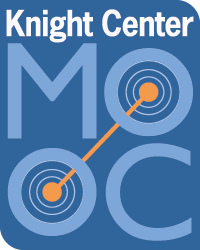

After five weeks with some of the top data journalism experts in the field and attracting 3,700 participants in more than 143 countries, “Data-Driven Journalism: The Basics,” the Knight Center for Journalism in the Americas’ most innovative Massive Open Online Course to date, will come to an end this Monday.
The five-week course began on Aug. 12 and will officially conclude on Sep. 16. The instructors were five journalists from some of the leading news organizations in the United States: The New York Times’ Derek Willis, National Public Radio’s Jeremy Bowers, the Houston Chronicle’s Lise Olsen, ProPublica’s Sisi Wei, and San Diego State University’s Amy Schmitz Weiss.
The course was a successful experiment as it represented the first time the Knight Center gathered multiple instructors to teach one course.
“We tried a new formula this time, assigning the training to a university professor and four professionals who are in the cutting edge of data journalism in some of the most important news organizations in the United States. The result was excellent,” said Professor Rosental Alves, founding director of the Knight Center. “I hope we will repeat this formula in other MOOCs in the future, as it creates the perfect bridge between the journalism industry and the academia, offering a unique learning opportunity to thousands of people around the world.”

From left to right: Instructors Sisi Wei, Derek Willis, Lise Olsen, Jeremy Bowers and Amy Schmitz Weiss.
By the last week of the course, “Data-Driven Journalism: The Basics” had attracted 3,724 students from 143 countries, with most of them coming from the United States, the United Kingdom, Spain, Brazil, Canada, Russia, Netherlands, India, Italy and Mexico. Other participants came from countries like Germany, Colombia, France, Congo, Hong Kong, China, Finland, Kenya, Portugal and Peru.
The course was characterized by high participation on its Facebook group page and through the Twitter hashtag #datajmooc.
Participant Daniela Guazo, with Mexico’s MEPI Foundation, shared on the Facebook group page several maps she produced, including one made with Fusion Tables showing the number of prisoners in each Mexican state per every 100,000 inhabitants.
Participant Diogo Antonio Rodriguez prepared a graphic of the different music genres that would be represented at an upcoming festival in Rio de Janeiro.
And student Jorge Pérez used the tools he learned in the course to scrape data from PDFs and produce a graphic on the Mexican government’s advertising expenses in the last decade.
Students shared their comments and projects through Twitter:
“Data-Driven Journalism: The Basics” gave participants an overview of what data-driven journalism is and how it is practiced in newsrooms in the United States. Besides learning about the basics of this increasingly vital discipline, students learned how data is used in the media industry today, where to locate data, how to clean and analyze it critically, and how to optimize the presentation of information for maximum readability and interactivity.
The course responds to the growing international interest in data journalism and follows the Knight Center’s highly popular MOOC in Spanish, “Introduction to Data Journalism,” with instructor Sandra Crucianelli. The course concluded last month after attracting nearly 4,000 people from 62 different countries.
Prior to that, the Knight Center offered the MOOC “How to Improve Electoral Coverage,” which was taught in Spanish by acclaimed Colombian journalist María Teresa Ronderos and concluded on April 2013. The course had 1,772 participants from 45 countries.
The first Knight Center MOOC was “Introduction to Infographics and Data Visualization,” taught last year by instructor Alberto Cairo with more than 2,000 students. The course was so well received that the Knight Center offered a second edition this year, identical to the first. It concluded in February with 5,000 students from 133 countries.
The Knight Center became a pioneer in massive journalism online education when it launched its MOOC program in Oct. 2012. Unlike most MOOCs, the Knight Center’s massive courses are created specifically for this program and seek to encourage the largest amount of student-to-student and instructor-to-students interactions as possible.
The Knight Center for Journalism in the Americas was created in 2002 by Professor Rosental Alves at the University of Texas at Austin School of Journalism thanks to a generous donation from the John S. and James L. Knight Foundation, which has been supporting it continually. The Center also receives major contributions from the Open Society Foundations and The University of Texas at Austin. The Center’s main goal is to help journalists in Latin American and the Caribbean to improve the quality of journalism in their countries.

Knight Center for Journalism in the Americas
300 West Dean Keeton
Room 3.212
Austin, TX, 78712
Phone: 512-471-1391
Email: journalismcourses@austin.utexas.edu